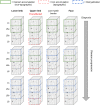Multimodal layer modelling reveals in vivo pathology in amyotrophic lateral sclerosis
- PMID: 37815224
- PMCID: PMC10907094
- DOI: 10.1093/brain/awad351
Multimodal layer modelling reveals in vivo pathology in amyotrophic lateral sclerosis
Abstract
Amyotrophic lateral sclerosis (ALS) is a rapidly progressing neurodegenerative disease characterized by the loss of motor control. Current understanding of ALS pathology is largely based on post-mortem investigations at advanced disease stages. A systematic in vivo description of the microstructural changes that characterize early stage ALS, and their subsequent development, is so far lacking. Recent advances in ultra-high field (7 T) MRI data modelling allow us to investigate cortical layers in vivo. Given the layer-specific and topographic signature of ALS pathology, we combined submillimetre structural 7 T MRI data (qT1, QSM), functional localizers of body parts (upper limb, lower limb, face) and layer modelling to systematically describe pathology in the primary motor cortex (M1), in 12 living ALS patients with reference to 12 matched controls. Longitudinal sampling was performed for a subset of patients. We calculated multimodal pathology maps for each layer (superficial layer, layer 5a, layer 5b, layer 6) of M1 to identify hot spots of demyelination, iron and calcium accumulation in different cortical fields. We show preserved mean cortical thickness and layer architecture of M1, despite significantly increased iron in layer 6 and significantly increased calcium in layer 5a and superficial layer, in patients compared to controls. The behaviourally first-affected cortical field shows significantly increased iron in L6 compared to other fields, while calcium accumulation is atopographic and significantly increased in the low myelin borders between cortical fields compared to the fields themselves. A subset of patients with longitudinal data shows that the low myelin borders are particularly disrupted and that calcium hot spots, but to a lesser extent iron hot spots, precede demyelination. Finally, we highlight that a very slow progressing patient (Patient P4) shows a distinct pathology profile compared to the other patients. Our data show that layer-specific markers of in vivo pathology can be identified in ALS patients with a single 7 T MRI measurement after first diagnosis, and that such data provide critical insights into the individual disease state. Our data highlight the non-topographic architecture of ALS disease spread and the role of calcium, rather than iron accumulation, in predicting future demyelination. We also highlight a potentially important role of low myelin borders, that are known to connect to multiple areas within the M1 architecture, in disease spread. Finally, the distinct pathology profile of a very-slow progressing patient (Patient P4) highlights a distinction between disease duration and progression. Our findings demonstrate the importance of in vivo histology imaging for the diagnosis and prognosis of neurodegenerative diseases such as ALS.
Keywords: biomarker; disease prediction; individualised medicine; motor neuron disease; neurodegeneration.
© The Author(s) 2023. Published by Oxford University Press on behalf of the Guarantors of Brain.
Conflict of interest statement
The authors report no competing interests.
Figures





References
-
- Al-Chalabi A, Hardiman O, Kiernan MC, Chiò A, Rix-Brooks B, van den Berg LH. Amyotrophic lateral sclerosis: Moving towards a new classification system. Lancet Neurol. 2016;15:1182–1194. - PubMed
-
- Norris F, Shepherd R, Denys E, et al. Onset, natural history and outcome in idiopathic adult motor neuron disease. J Neurol Sci. 1993;118:48–55. - PubMed
-
- Hammer RP, Tomiyasu U, Scheibel AB. Degeneration of the human Betz cell due to amyotrophic lateral sclerosis. Exp Neurol. 1979;63:336–346. - PubMed
Publication types
MeSH terms
Substances
Grants and funding
LinkOut - more resources
Full Text Sources
Medical
Miscellaneous

